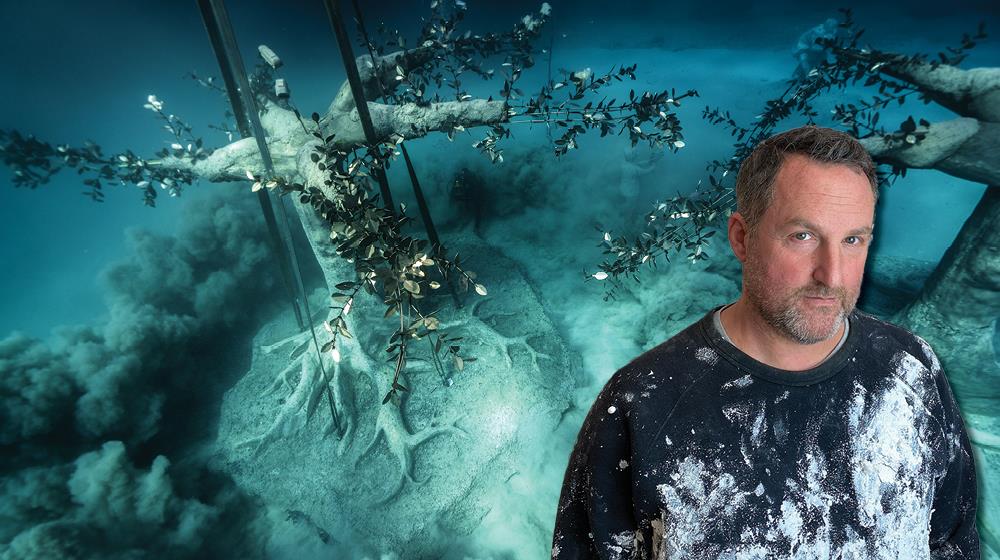The Museum of Underwater Sculpture Ayia Napa (MUSAN) – the first of its kind in the Mediterranean – is a popular and particularly compelling work by Jason deCaires Taylor, a British sculptor, environmentalist and professional underwater photographer.
When talking about the project, Taylor has revealed he was deeply affected by conversations with local people, who spoke of a time when the island’s forests were denser and its seas teemed with marine life. These stories moved him significantly, prompting a desire to “reforest” the ocean floor using symbolic trees and structures capable of nurturing the return of marine species.
“Cyprus also holds a deep maritime legacy – the sea has shaped its history, identity and myths. With its rich tradition of seafaring and submerged archaeological sites, I wanted the installation to evoke that same sense of discovery, as if you were swimming through a lost, living archive of culture and ecology intertwined,” he has said.

After graduating from the London Institute of Arts in 1998 with a BA Honours in Sculpture, Taylor became the first of a new generation of artists to shift the concepts of the Land Art Movement into the realm of the marine environment.
As MUSCAN also reflects, his permanent site-specific sculptural works are predominantly exhibited in submerged and tidal marine environments, exploring modern themes of conservation and environmental activism. In 2006, Taylor gained international recognition with the creation of the world’s first underwater sculpture park, situated off the coast of Grenada in the West Indies. Taylor has gone on to produce over 1,200 public terrestrial and underwater sculptures worldwide.
Treading on the threshold between the real and the fantastical
Sculptor Jason deCaires Taylor seems to exist in a state of delicate balance –effortlessly treading on the threshold between the real and the fantastical. One could say he is the gatekeeper of an ocean world, where mystery and myth breathe side by side. His underwater sculptures are not merely installations; they are portals into another dimension. Spanning the globe – from Mexico to the Maldives, from Grenada to Lanzarote – his underwater museums are masterful unions of artistic finesse, scientific mindfulness and technical precision.
Taylor’s childhood unfolded across Europe, Asia and the Caribbean – regions rich in contrast, as regards both landscape and culture. Their impact was indelible. From a young age, he carried within him an insatiable curiosity and a belief that beyond every familiar horizon lay other ways of life – entire worlds waiting to be discovered.
“That same feeling returns the moment you slip beneath the surface of the ocean. You're entering a frontier that still holds vast mystery – a place that humbles and inspires in equal measure,” he confides. “As an artist, stepping into this environment is unlike anything else. Few have truly explored it through a creative lens. The rules shift: colour is filtered and refracted, light behaves unpredictably, you are suspended and your relationship to space and time becomes fluid. It’s a place where conventional thinking dissolves. What emerges instead is a kaleidoscope of possibilities – not just for artistic expression but for reimagining our connection to the planet itself.”

Installations that also serve as artificial reefs
Though now inextricably linked to the sea, Taylor’s journey began on solid ground. While at college in London, he created a number of temporary public installations – visually striking but, in his view, lacking a certain depth. “That question stayed with me,” he admits. “Then I discovered that placing sculptures underwater could do more than just provoke thought – it could actively contribute to marine ecosystems. These installations could serve as artificial reefs, attracting marine life, and even help divert pressure away from fragile natural habitats. In that moment, everything aligned. Art became not just a medium for expression but a tool for regeneration – a bridge between creativity and conservation.”
With reverence for the ocean’s sheer force and unpredictability, Taylor speaks of the technical challenges behind his practice. “The ocean is a volatile and powerful force. It places immense pressure on every installation, so engineering becomes just as critical as the creative process,” he explains, filled with quiet respect. “At the same time, there's a profound sense of letting go. I’m constantly experimenting, exploring new techniques to evolve my practice but, in this environment, outcomes are often unpredictable. The ocean has the final say. In many ways, it's a collaboration with nature itself. You guide the idea into place and then you step back and allow the elements to shape its future.”

Every project begins with the local context, which for Taylor is the cornerstone of authenticity. “It shapes everything,” he says. The aim is always to produce work that resonates meaningfully with the community. Over time, these creations often evolve into cultural landmarks, as people begin to form personal relationships with them. Politics, too, he notes, plays a part. Many of his installations are government-funded and demand layers of local approval. While such involvement can offer visibility and backing, it also carries risk. “There's always the risk of the work becoming entangled in campaigns or agendas,” he notes – an enduring reminder that public art holds a unique capacity to influence public discourse.
Each project has left its mark on him, expanding his own artistic sensibilities and transforming his worldview. Yet it was his first underwater installation, in 2006, that proved to be truly transformative. “From the moment it came to life, I realised that I had discovered something rare. Very few artworks have the power to regenerate an ecosystem, to explore our relationship with nature in such a visceral way and to exist within a living, ever-shifting environment. It wasn’t just a creative breakthrough – it marked the beginning of an entirely new path, where art, science and ecology intersect. I knew, without question, that my life would never be the same.”
And indeed, how could it be? Since that moment, Jason deCaires Taylor has tiptoed between myth, reality and the shimmering depths of saltwater dreams. How, truly, does one ever return from that?










